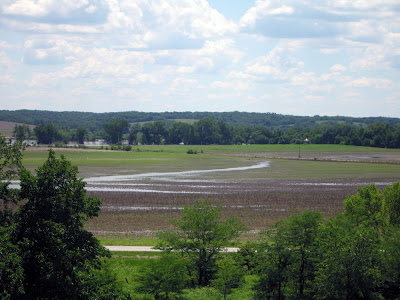
For as long as humanity has been gazing out across the Des Moines River valley toward the Soap Creek hills --- and that’s a few thousand years now, give or take a millenium --- we’ve been doing it from here: a natural observatory that is the prow of Iowaville Cemetery.
I head downriver from Eldon to Douds-Leando and beyond along Highway 16 several times a year and just before Selma, often turn off onto the twisting lane that leads up into this cleared slot in the wooded bluff, pull off about halfway up, then walk back west onto the point, stand shoulder-to-shoulder with what may or may not be Black Hawk --- and just look.
It’s an amazing way to restore perspective.
Iowa’s mound-builders were here first and I’m told their creations can be found, if you know where to look, along the ridge.
Highway 16 itself is a fairly recent innovation, following the general route of a vanished rail line around base of the eastern rim of the valley. Before that, the main trail edged the river --- and still does, although it’s rutted gravel from Iowaville up to Eldon and closed entirely from Iowaville down to Selma.

Look carefully into the distance and you’ll see a narrow north-south gravel road leading from Highway 16 down to the riverside. This is the road to the village of Iowaville, laid out in 1838 by trader James Jordan and others. The road was at its east boundary; the Van Buren-Davis county line (also the west border of the Black Hawk Purchase), it’s western limit.
But long before that, this was the site (or near the site) of the principal village of the Ioway people, who found refuge in this broad valley as early as 1720 after their numbers had been drastically reduced by diseases of the whites.
Perhaps a century later, 1819-1824 depending upon who you believe, the Sauk and Fox (Meskwaki) with Black Hawk as a secondary commander, virtually finished off the Ioways by massacring hundreds of them as a great celebration was under way out there in the valley. Their bones are just under the surface.
After the Black Hawk War, Black Hawk himself came here to die --- in the fall of 1838 upstream from Iowaville along the river not far from trader James Jordan’s home. He was buried a little farther upstream for a time --- until an enterprising white who had visions of making money by displaying it swiped the head (or the whole body), boiled away the remaining flesh and vamoosed.
There’s a very old tradition in these parts that only the head was taken and that the remaining bones were brought up here to all that remains of Iowaville and buried, which is why it’s possible to stand by Black Hawk’s grave even though it’s entirely possible the old chief isn’t in it. It all depends on what you want to believe, as most things do.
Iowaville itself was doomed --- too close to the river, too many floods. And now everything is gone out there except the land and the river. The last of the buildings, Robert Rathbun’s Iowaville House hotel, long a farmhouse, came down in the 1950s; James Jordan’s mansion, in the 1960s.
There’s not a sign, not a marker, nothing to indicate that history swirls around you here like falling leaves in a brisk October wind.
That’s the way it works you know. We’re mighty small stuff, despite the size our heads sometimes grow to; and the troubles of today have little or no meaning in the grand scheme of things. The river will keep flowing, dirt will cover our bones and we’ll be forgotten. And that’s not a bad thing.


1 comment:
I have been to what we called the killing fields back when I was a kid to pickup beads, French trader beads. Early spring after a soaking rain, you could see bone fragments all along the surface on the ground. I hated to go in there for fear that the bones would stick to the bottom of my shoes. I picked up a lot ofartifacts a lead shot ball flat one side, a peacepipe bowl, a button of a French solders uniform, and a pill bottle full of beads. I believe that this place is very secred and needs to be preserved even if the native americans need to be involved. the place in an open field where anybody can go in.
Post a Comment